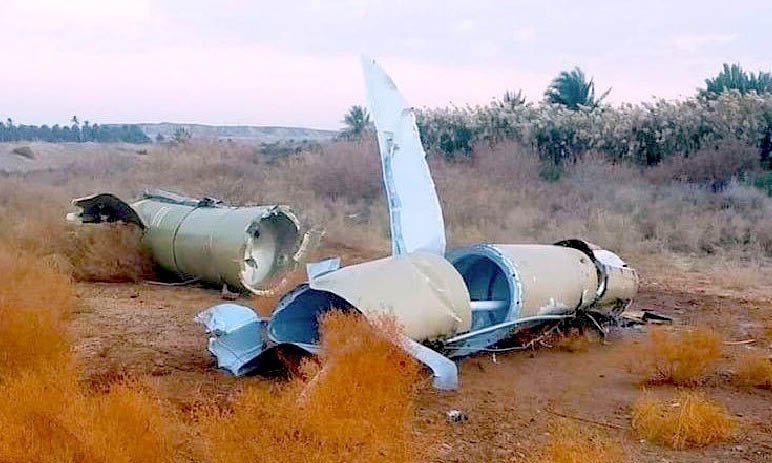above image: Remains of one of the Iranian ballistic missiles (maybe) the Zelzal, codenamed Great Prophet-6, which fell near the base of Erbil – click here to see the video of a launch
by Fabio Giuseppe Carlo Carisio for VT Italy
UPDATE JANUARY, 11
It is a mystery about the 80 dead and 200 injured that the Iranian missile attacks would have caused, according to Iranian TV, in the American bases of Al Asad and Erbil in Iraq. Both US President Donal Trump and the Iraqi authorities have denied the circumstance. In particular, news came from Baghdad that Tehran had warned the Iraqi government and army of the military operation, allowing both Iraqis and Americans (and foreigners of the NATO contingent including the Italians) to hide in the fortified areas. But an unequivocal satellite image also denies Trump about the fact that the missiles did “little damage”.
The photo with various craters demonstrates the numerous areas of the Al Asad base where deposits, planes, drones and helicopters have been damaged in a budget that the Pentagon has no intention of revealing in order not to recognize the opponent’s firepower. The craters created by missiles in the American base of Ain Al Asad in Iraq This was highlighted in an article in VT (previously published in Russia Today) by Scott Ritter, a former U.S. Marine Corps intelligence officer. He served in the Soviet Union as an inspector for the implementation of the INF Treaty, in the staff of General Schwarzkopf during the Gulf War, and from 1991-1998 as a United Nations arms inspector.

According to Ritter Tehran, in response to the assassination of Qassem Soleimani did not hit to kill but to demonstrate his strength with the new hyper-technological cruise missiles, used with surgical precision together with the ballistic ones, which unlike the first ones are not remotely controlled but launched with a target set by increasing the margin of error.
In fact, medium-long range rockets (from 500 to 800 km) have been used Qaim 1 and Fahad 313, the former extremely fast and precise, the latter equipped with a “jammer” type device, a frequency jammer used for mobile phones , able to avoid the interception of the Patriot anti-missile defense systems used by the Americans and already results of poor efficacy in the attack on the Aramco oil plants in Saudi Arabia.
One thing certain about the attack is that not one of the Iranian rockets was shot down by the Americans. The Revolutionary Guards of Tehran fired 17 missiles, 15 have reached the target and 2 have not exploded like the alleged Zelzal ballistic rocket that fell near Erbil in the main photo.
UPDATE JANUARY, 8
IIran, last night at 1,20 am Baghdad time (GMT + 3), launched the ‘Soleimani Martyr’ operation by launching a missile attack in Iraq against two bases that host American and coalition troops, including Italian soldiers. This is same hour in which was shot the US drone that killed the Iranian general at Baghdad airport on Friday night.
read more SOLEIMANI KILLED, BOEING SHOT DOWN, ISIS EXULTED: TRAITOR’S SHADOW INSIDE IRAN’S PASDARAN
A rain of cruise and short-range ballistic missiles left Iranian territory and hit the base of al-Asad and Erbil, as the first retaliation for the killing of General Qassem Soleimani by the USA.
GospaNews.net: Trump kills, Putin and Assad praise Our Lady for Orthodox Christmas in Damascus
According to Iranian state television, there was also a second wave of attacks.
A first death toll speaks of 80 dead. The personnel of the Italian military contingent in Erbil gathered in a security area – according to what ANSA learned – and the men took refuge in special bunkers. They are all unharmed.
The Pentagon said in a statement that after informing US President Donald Trump of the facts, he is still considering the consequences of the offensive.
IRGC, the Iranian Revolutionary Guard Corps, has also warned all U.S. allies in the region that they will be targeted if any aggressive action is taken from their territory, warning Kuwait, Bahrain, Saudi Arabia, Jordan, and Israel.
MANY AIRLINES SUSPEND FLIGHTS
Several airlines have decided to avoid Iranian airspace, in a phase of very high tension between the Islamic Republic and the United States after the missile attacks on the American bases in Iraq. On the same night, a Ukrainian Boeing crashed between Tehran and Kiev, causing 177 deaths and no survivors.
The Ukrainian Embassy in Tehran spoke – a few hours before the events – of an accident due to an engine problem, not a terrorist action.
GospaNews.net: Iran’s revenge starts from Qom. Thanks to Fordow’s nuclear bunker plant
Air France suspends overflights of Iran and Iraq Air France has suspended until further notice “all overflights of Iranian and Iraqi airspace”, a few hours after the Iranian attacks. Alitalia: no flights to Tehran Alitalia does not operate flights to Iran, while as regards the connections with New Delhi (India) and the Maldives, the airline’s planes, as well as those of the other airlines, use alternative routes to those that they fly over Iraq and Iran.
The US Federal Aviation Administration has, of course, issued a warning for commercial aircraft, prohibiting them from “operating in the airspace of Iraq, Iran and the waters of the Persian Gulf and the Gulf of Oman”. This warning has a relative impact on air traffic because major US airlines are not operating in Iran. Only United had to change the course of one of its flights.
GospaNews.net: Hackers against Trump & Pompeo dirty lies: about Iraq and Venezuela plots
Singapore and EVA Air Singapore Airlines, for its part, announced today that its flights to and from Europe will no longer pass through Iranian airspace. A spokesman for EVA Air, the carrier from Taiwan, did the same.
- UPDATE AND MORE INFO HERE
- GOSPA NEWS – WARZONE INVESTIGATIONS & REPORTS
- Turkish papers: 21 Erdogan’s jihadist militias supported by Cia, Pentagon and armed with TOW missiles

Fabio is Director and Editor of Gospa News; a Christian Information Journal.
Fabio Giuseppe Carlo Carisio, born on 24/2/1967 in Borgosesia, started working as a reporter when he was only 19 years old in the alpine area of Valsesia, Piedmont, his birth region in Italy. After studying literature and history at the Catholic University of the Sacred Heart in Milan, he became director of the local newspaper Notizia Oggi Vercelli and specialized in judicial reporting.
For about 15 years he is a correspondent from Northern Italy for the Italian newspapers Libero and Il Giornale, also writing important revelations on the Ustica massacre, a report on Freemasonry and organized crime.
With independent investigations, he collaborates with Carabinieri and Guardia di Finanza in important investigations that conclude with the arrest of Camorra entrepreneurs or corrupt politicians.
In July 2018 he found the counter-information web media Gospa News focused on geopolitics, terrorism, Middle East, and military intelligence.
His articles were published on many international media and website as SouthFront, Reseau International, Sputnik Italia, United Nation Association Westminster, Global Research, Kolozeg and more…
His investigations was quoted also by The Gateway Pundit, Tasnim and others
He worked for many years for the magazine Art & Wine as an art critic and curator.
ATTENTION READERS
We See The World From All Sides and Want YOU To Be Fully InformedIn fact, intentional disinformation is a disgraceful scourge in media today. So to assuage any possible errant incorrect information posted herein, we strongly encourage you to seek corroboration from other non-VT sources before forming an educated opinion.
About VT - Policies & Disclosures - Comment Policy





Thanks Us-First. It’s very difficult write truth in Us too
1. Aircraft – its on-board systems – are easy enough to crack. This was repeatedly proved by “curious enthusiasts”: “Today at the Hack In The Box conference in Amsterdam, a report was made by Hugo Teso, a security consultant from n.runs AG, about a completely reliable scenario of hijacking with a simple Android application. Taking advantage of two new aviation systems for vulnerability detection, information gathering and exploitation, creating a framework (SIMON) and an Android application (PlaneSploit) that deliver an attacking message to the flight management system of the aircraft (Flight Management Systems), he demonstrated the ability to gain complete control over the aircraft making the virtual plane “dance to its own tune.” And could, for example, start the engines at random – one for traction, and the other in reverse, which would lead to an accident.
Thanks Andy for your always hyper-technical explications: it’s an honour that you read me. I’m just a journalist! Bye, Fabio
Oh, i’m just an ordinary reader 🙂 I can’t paste the second part of my message. Don’t know why VT doesn’t accept it. Some tech problems.
Yes, Fabio; your reports are much appreciated by all readers as indeed are Andy’s much-valued responses on all that concerns us. You both impact and establish a global reach that adds to the clout of VT.
@US-First: thank you!
Comments are closed.